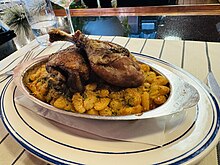Cassoulet
The food writer Elizabeth David described it as "that sumptuous amalgamation of haricot beans, sausage, pork, mutton and preserved goose, aromatically spiced with garlic and herbs".
The Michelin Guide comments that every town brings its own personal touch to the recipe, all claiming the title of the one and only stronghold of authentic cassoulet.
[13] Beck, Bertholle and Child comment that regardless of local custom, an extremely good cassoulet can be made anywhere out of beans with "whatever traditional meats are available: goose, game, pork, sausages, lamb, mutton".
[11] In 1996, the Etats généraux de la gastronomie traditionnelle française, a professional body dedicated to promoting regional products and traditional cuisine, specified the following proportions for cassoulet: at least 30 per cent pork (which can include sausage and Toulouse sausage), mutton or preserved goose; and up to 70 per cent haricot beans and stock, fresh pork rind, herbs and flavourings.
[12] David calls it a "sumptuous amalgamation of haricot beans, sausage, pork, mutton and preserved goose, aromatically spiced with garlic and herbs".
This has led to stories, such as the one given by David, citing Anatole France, of a single original cassoulet being extended for years or even decades.
